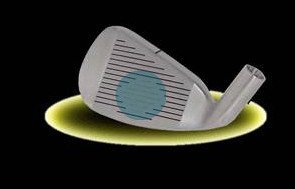
The “Sweet Spot” in golf refers to the center of the clubface, which is the optimal point of contact between the golf ball and the club. When the ball is struck with the sweet spot, it results in maximum distance, accuracy, and control. Understanding the sweet spot and how to consistently find it is crucial for improving your overall golf game. Let's take a closer look at the concept of the sweet spot and its significance in golf.
The significance of the sweet spot:
- Increased distance: Striking the ball with the sweet spot allows for the transfer of maximum energy from the clubhead to the ball. This energy transfer results in better compression of the ball, leading to increased distance.
- Better accuracy: Hitting the sweet spot ensures that the ball travels on the intended path. It minimizes sidespin and reduces the likelihood of hooking or slicing.
- Improved control: Shots struck with the sweet spot tend to have a more consistent trajectory and spin, allowing golfers to better control the flight of the ball.
Finding the sweet spot:
- Know your equipment: Each golf club has a different sweet spot location due to variations in design and size. Become familiar with your clubs and their sweet spot locations.
- Focus on the center: Aim to strike the ball at or near the center of the clubface. Keep your eyes on the ball throughout the swing and ensure that the clubface is square at impact.
- Balanced swing: Maintain a smooth and balanced swing to increase your chances of hitting the sweet spot. Avoid swinging too fast or too aggressively, as it can lead to off-center hits.
- Practice tempo and timing: Developing a consistent rhythm and timing in your swing can greatly assist in finding the sweet spot more frequently. Practice tempo drills and take your time to ensure a properly timed swing.
Signs of off-center hits:
- Loss of distance: When you miss the sweet spot, you are likely to experience a significant loss of distance compared to a shot struck with the sweet spot.
- Inaccurate shot shape: Shots struck away from the sweet spot tend to have a more pronounced curve. Hooks and slices are common when contact is made closer to the heel or toe of the clubface.
- Less control: Off-center hits often result in inconsistent trajectories and spin, making it difficult to control the direction and flight of the ball.
Impact of club type:
- Woods and drivers: These clubs generally have larger clubheads, which provide a larger sweet spot. This forgiving nature allows golfers to achieve more distance even on off-center hits.
- Irons: Irons have smaller clubheads, making it slightly more challenging to consistently find the sweet spot. However, practicing with irons can enhance your precision and ball-striking skills.
- Putters: The sweet spot on a putter is typically located in the center or slightly higher. Striking the ball with the sweet spot on a putter leads to better roll and distance control.
In conclusion, the sweet spot is a critical aspect of golf. It directly affects the distance, accuracy, and control of your shots. By understanding the significance of the sweet spot and practicing to consistently find it, you can greatly enhance your golf game. Remember to focus on your equipment, maintain a balanced swing, and strive for a centered impact.





